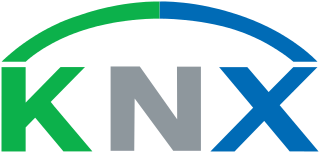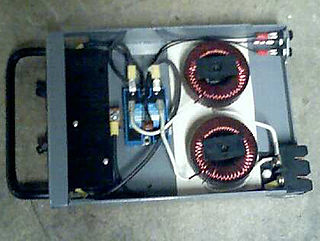
In computer architecture, a bus is a communication system that transfers data between components inside a computer, or between computers. This expression covers all related hardware components and software, including communication protocols.

Small Computer System Interface is a set of standards for physically connecting and transferring data between computers and peripheral devices, best known for its use with storage devices such as hard disk drives. SCSI was introduced in the 1980s and has seen widespread use on servers and high-end workstations, with new SCSI standards being published as recently as SAS-4 in 2017.

X10 is a protocol for communication among electronic devices used for home automation (domotics). It primarily uses power line wiring for signaling and control, where the signals involve brief radio frequency bursts representing digital information. A wireless radio-based protocol transport is also defined.

KNX is an open standard for commercial and residential building automation. KNX devices can manage lighting, blinds and shutters, HVAC, security systems, energy management, audio video, white goods, displays, remote control, etc. KNX evolved from three earlier standards; the European Home Systems Protocol (EHS), BatiBUS, and the European Installation Bus.

DMX512 is a standard for digital communication networks that are commonly used to control lighting and effects. It was originally intended as a standardized method for controlling stage lighting dimmers, which, prior to DMX512, had employed various incompatible proprietary protocols. It quickly became the primary method for linking controllers to dimmers and special effects devices such as fog machines and intelligent lights.
Serial Peripheral Interface (SPI) is a de facto standard for synchronous serial communication, used primarily in embedded systems for short-distance wired communication between integrated circuits.

A dimmer is a device connected to a light fixture and used to lower the brightness of the light. By changing the voltage waveform applied to the lamp, it is possible to lower the intensity of the light output. Although variable-voltage devices are used for various purposes, the term dimmer is generally reserved for those intended to control light output from resistive incandescent, halogen, and compact fluorescent lamps (CFLs) and light-emitting diodes (LEDs). More specialized equipment is needed to dim fluorescent, mercury-vapor, solid-state, and other arc lighting.

A lighting control console is an electronic device used in theatrical lighting design to control multiple stage lights at once. They are used throughout the entertainment industry and are normally placed at the front of house (FOH) position or in a control booth.

Show control is the use of automation technology to link together and operate multiple entertainment control systems in a coordinated manner. It is distinguished from an entertainment control system, which is specific to a single theatrical department, system or effect, one which coordinates elements within a single entertainment discipline such as lighting, sound, video, rigging, or pyrotechnics. A typical entertainment control system would be a lighting control console. An example of show control would be linking a video segment with a number of lighting cues, or having a sound cue trigger animatronic movements, or all of these combined. Shows with or without live actors can almost invariably incorporate entertainment control technology and usually benefit from show control to operate these subsystems independently, simultaneously, or in rapid succession.
Architecture for Control Networks (ACN) is a suite of network protocols for control of entertainment technology equipment, particularly as used in live performance or large-scale installations. For example, lighting, audio or special effects equipment. ACN is maintained by Entertainment Services and Technology Association and its first official release was ANSI Standard E1.17-2006 - Entertainment Technology - Architecture for Control Networks. The standard was subsequently revised and released as ANSI E1.17-2010.
Building automation(BAS), also known as building management system (BMS) or building energy management system (BEMS), is the automatic centralized control of a building's HVAC (heating, ventilation and air conditioning), electrical, lighting, shading, access control, security systems, and other interrelated systems. Some objectives of building automation are improved occupant comfort, efficient operation of building systems, reduction in energy consumption, reduced operating and maintaining costs and increased security.
Remote Device Management(RDM) is an addition to the DMX512 control protocol for stage lighting equipment, introduced in 2006. DMX512 was developed in the late 1980s as a standard protocol for lighting consoles to communicate with dimmers, but has since been used for more complex applications, including the control of intelligent lighting fixtures. The addition of RDM addresses many of the shortcomings of DMX512, which is unidirectional with no support for metadata.

A lighting control system incorporates communication between various system inputs and outputs related to lighting control with the use of one or more central computing devices. Lighting control systems are widely used on both indoor and outdoor lighting of commercial, industrial, and residential spaces. Lighting control systems are sometimes referred to under the term smart lighting. Lighting control systems serve to provide the right amount of light where and when it is needed.
SCSI Enclosure Services (SES) is a protocol for more modern SCSI enclosure products. An initiator can communicate with the enclosure using a specialized set of SCSI commands to access power, cooling, and other non-data characteristics.
Philips Dynalite is a lighting control and automation system developed in Sydney, Australia by John Gunton in 1987.
0–10 V is one of the first and simplest electronic lighting control signaling systems, used as an early fluorescent dimming system. Simply put, the control signal is a DC voltage that varies between zero and ten volts. Two standards are recognized: current sourcing and current sinking.

Digital Addressable Lighting Interface (DALI) is a trademark for network-based products that control lighting. The underlying technology was established by a consortium of lighting equipment manufacturers as a successor for 1-10 V/0–10 V lighting control systems, and as an open standard alternative to several proprietary protocols. The DALI, DALI-2 and D4i trademarks are owned by the lighting industry alliance, DiiA.
C-Bus is a communications protocol based on a seven-layer OSI model for home and building automation that can handle cable lengths up to 1000 metres using Cat-5 cable. It is used in Australia, New Zealand, Asia, the Middle East, Russia, United States, South Africa, the UK and, other parts of Europe including Greece and Romania. C-Bus was created by Clipsal Australia's Clipsal Integrated Systems division for use with its brand of home automation and building lighting control system. C-Bus has been briefly available in the United States but Schneider Electric has now discontinued sales in the United States.
Art-Net is a royalty-free communications protocol for transmitting the DMX512-A lighting control protocol and Remote Device management (RDM) protocol over the User Datagram Protocol (UDP) of the Internet protocol suite. It is used to communicate between "nodes" and a "server".









